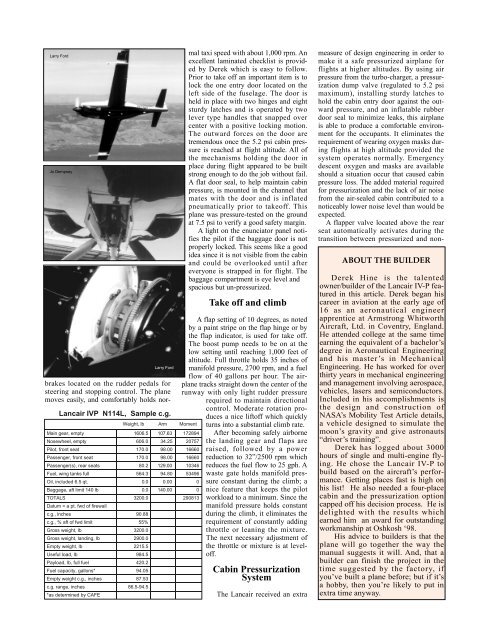Lancair IV-P - CAFE Foundation
Lancair IV-P - CAFE Foundation
Lancair IV-P - CAFE Foundation
- No tags were found...
Create successful ePaper yourself
Turn your PDF publications into a flip-book with our unique Google optimized e-Paper software.
Larry FordJo DempseyMain gear, emptyNosewheel, emptyPilot, front seatPassenger, front seatPassenger(s), rear seatsFuel, wing tanks fullOil, included 6.5 qt.Baggage, aft limit 140 lbTOTALSDatum = a pt. fwd of firewallc.g., inchesc.g., % aft of fwd limitGross weight, lbGross weight, landing, lbEmpty weight, lbUseful load, lbPayload, lb, full fuelFuel capacity, gallons*Empty weight c.g., inchesc.g. range, inches*as determined by <strong>CAFE</strong>Weight, lb1606.5606.0170.0170.080.2564.30.00.03200.090.8855%3200.02900.02215.5984.5420.294.0587.5386.5-94.5Larry Ford<strong>Lancair</strong> <strong>IV</strong>P N114L, Sample c.g.Arm107.6334.2598.0098.00129.0094.800.00140.00brakes located on the rudder pedals forsteering and stopping control. The planemoves easily, and comfortably holds normaltaxi speed with about 1,000 rpm. Anexcellent laminated checklist is providedby Derek which is easy to follow.Prior to take off an important item is tolock the one entry door located on theleft side of the fuselage. The door isheld in place with two hinges and eightsturdy latches and is operated by twolever type handles that snapped overcenter with a positive locking motion.The outward forces on the door aretremendous once the 5.2 psi cabin pressureis reached at flight altitude. All ofthe mechanisms holding the door inplace during flight appeared to be builtstrong enough to do the job without fail.A flat door seal, to help maintain cabinpressure, is mounted in the channel thatmates with the door and is inflatedpneumatically prior to takeoff. Thisplane was pressure-tested on the groundat 7.5 psi to verify a good safety margin.A light on the enunciator panel notifiesthe pilot if the baggage door is notproperly locked. This seems like a goodidea since it is not visible from the cabinand could be overlooked until aftereveryone is strapped in for flight. Thebaggage compartment is eye level andspacious but un-pressurized.Take off and climbA flap setting of 10 degrees, as notedby a paint stripe on the flap hinge or bythe flap indicator, is used for take off.The boost pump needs to be on at thelow setting until reaching 1,000 feet ofaltitude. Full throttle holds 35 inches ofmanifold pressure, 2700 rpm, and a fuelflow of 40 gallons per hour. The airplanetracks straight down the center of therunway with only light rudder pressurerequired to maintain directionalcontrol. Moderate rotation producesa nice liftoff which quicklyMoment turns into a substantial climb rate.172894 After becoming safely airborne20757 the landing gear and flaps are16660 raised, followed by a power16660 reduction to 32”/2500 rpm which10346 reduces the fuel flow to 25 gph. A53496 waste gate holds manifold pressureconstant during the climb; a00 nice feature that keeps the pilot290813 workload to a minimum. Since themanifold pressure holds constantduring the climb, it eliminates therequirement of constantly addingthrottle or leaning the mixture.The next necessary adjustment ofthe throttle or mixture is at leveloff.Cabin PressurizationSystemThe <strong>Lancair</strong> received an extrameasure of design engineering in order tomake it a safe pressurized airplane forflights at higher altitudes. By using airpressure from the turbo-charger, a pressurizationdump valve (regulated to 5.2 psimaximum), installing sturdy latches tohold the cabin entry door against the outwardpressure, and an inflatable rubberdoor seal to minimize leaks, this airplaneis able to produce a comfortable environmentfor the occupants. It eliminates therequirement of wearing oxygen masks duringflights at high altitude provided thesystem operates normally. Emergencydescent oxygen and masks are availableshould a situation occur that caused cabinpressure loss. The added material requiredfor pressurization and the lack of air noisefrom the air-sealed cabin contributed to anoticeably lower noise level than would beexpected.A flapper valve located above the rearseat automatically activates during thetransition between pressurized and non-ABOUT THE BUILDERDerek Hine is the talentedowner/builder of the <strong>Lancair</strong> <strong>IV</strong>-P featuredin this article. Derek began hiscareer in aviation at the early age of16 as an aeronautical engineerapprentice at Armstrong WhitworthAircraft, Ltd. in Coventry, England.He attended college at the same timeearning the equivalent of a bachelor’sdegree in Aeronautical Engineeringand his master’s in MechanicalEngineering. He has worked for overthirty years in mechanical engineeringand management involving aerospace,vehicles, lasers and semiconductors.Included in his accomplishments isthe design and construction ofNASA’s Mobility Test Article details,a vehicle designed to simulate themoon’s gravity and give astronauts“driver’s training”.Derek has logged about 3000hours of single and multi-engine flying.He chose the <strong>Lancair</strong> <strong>IV</strong>-P tobuild based on the aircraft’s performance.Getting places fast is high onhis list! He also needed a four-placecabin and the pressurization optioncapped off his decision process. He isdelighted with the results whichearned him an award for outstandingworkmanship at Oshkosh ‘98.His advice to builders is that theplane will go together the way themanual suggests it will. And, that abuilder can finish the project in thetime suggested by the factory, ifyou’ve built a plane before; but if it’sa hobby, then you’re likely to put inextra time anyway.
















